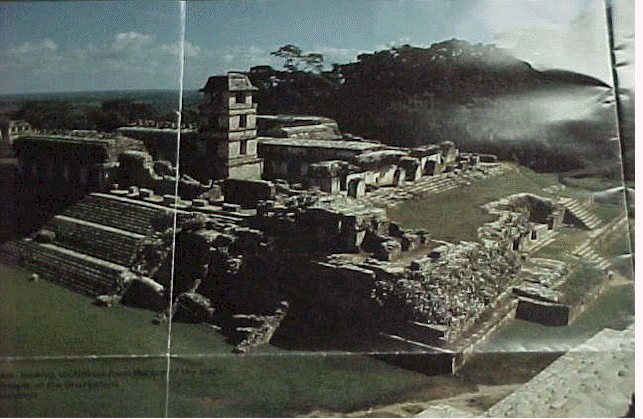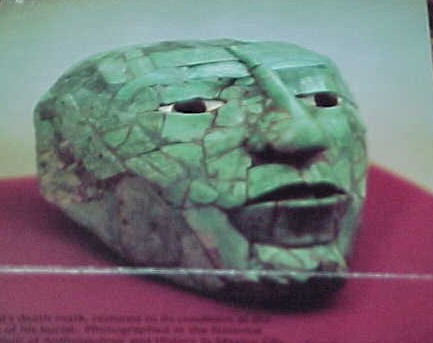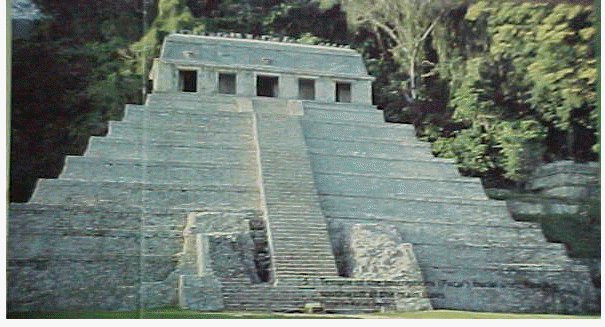Palenque
In the Foothills of Chipas, Mexico lies Maya city of Palenque. This ancient Maya city is located
in the western frontier of the lowland Maya Region. But the name Palenque wasn't the
actual site's name. The name of Palenque came from a nearby village. The
flood plain of the Usumacinta river to the north provided Palenque with its resources.
The
city of Palenque began as a small city. Dates on the Maya long count calendar
carved on walls from the first to the last quarters of nine baktun (from 514 A.D. to 784
A.D.) indicated this as the time of Palenque's flourishing. During this time some of
Palenque's greatest structures were built, when Lord Pacal, and his sons Chan Bahlum, and
Kan Xul were in rule over Palenque.
The
city of Palenque had many great structures. Some of these great structures of
Palenque include the: Temple of Inscriptions, Temple of the Sun, the Temple of the
Foliated Cross, the Palenque of Palace, the Temple XII, and the Temple of the cross.
 The
Palace of Palenque is probably one of the greatest structures in Palenque along with the
Temple of Inscriptions. The Palace is 228 ft long 200 ft wide, and it stands on a
truncated pyramid 30 ft wide and 30 ft high. The Palace is built with a large number
of rooms and galleries placed around four courts. The walls are decorated with mural
paintings and carved stone slabs. In the southwestern court there is a square tower
which was originally 72 ft above the floor of the court. The tower has a basement
which is solid . It is three stories with large windows looking toward the four
cardinal directions. There is a small blind chamber between the first and second
stories. The chamber is connected by and inner staircase. There is some
evidence that the palace was added to Palenque somewhere around 602 A.D. to 783 A.D.
The
Palace of Palenque is probably one of the greatest structures in Palenque along with the
Temple of Inscriptions. The Palace is 228 ft long 200 ft wide, and it stands on a
truncated pyramid 30 ft wide and 30 ft high. The Palace is built with a large number
of rooms and galleries placed around four courts. The walls are decorated with mural
paintings and carved stone slabs. In the southwestern court there is a square tower
which was originally 72 ft above the floor of the court. The tower has a basement
which is solid . It is three stories with large windows looking toward the four
cardinal directions. There is a small blind chamber between the first and second
stories. The chamber is connected by and inner staircase. There is some
evidence that the palace was added to Palenque somewhere around 602 A.D. to 783 A.D.
The first structure when coming into the site is the Temple XII. The temple is also
known as the Temple of the Sun, or the Temple of the Dead Moon. From 1992-1994 close
to 500 objects were excavated from this temple. Today the Temple XII is in very poor
condition.
 The Temple of Inscriptions had just about the same
look as the other temples except that it was a little bigger. But that wasn't all
that was different... It was 1952 and Alberto Ruz was at the temple of Inscriptions.
Ruz realized after searching that the pyramid was raised over a vaulted chamber.
In the tomb Pacal was decorated with jewelry, He had a jade mask (to the right)
pearls, conch shells, pyrite, and jade ornaments. The sarcophagus was covered with a
lid and a carved slab, meaning a symbolic scene of death and resurrection. The walls
of the tomb were decorated with the nine gods of the underworld. There were also
five or six skeletons also found in the tomb, these were probably sacrifices for their
master.
The Temple of Inscriptions had just about the same
look as the other temples except that it was a little bigger. But that wasn't all
that was different... It was 1952 and Alberto Ruz was at the temple of Inscriptions.
Ruz realized after searching that the pyramid was raised over a vaulted chamber.
In the tomb Pacal was decorated with jewelry, He had a jade mask (to the right)
pearls, conch shells, pyrite, and jade ornaments. The sarcophagus was covered with a
lid and a carved slab, meaning a symbolic scene of death and resurrection. The walls
of the tomb were decorated with the nine gods of the underworld. There were also
five or six skeletons also found in the tomb, these were probably sacrifices for their
master.
Pacal founded the first dynasty at Palenque with his accession (rise to power) in 615 A.D.
According to the Inscriptions found he was born 603 A.D. and died in 684 A.D. But
the end of Pacal's reign did not mean that Palenque would fall. Glyphs indicated
that Pacal's successors and sons Chan Bahlum and Kan Xul ruled the city, for more
than another century. They also built some of the famous structures. They also
expanded Palenque's Territory.
615 A.D.
According to the Inscriptions found he was born 603 A.D. and died in 684 A.D. But
the end of Pacal's reign did not mean that Palenque would fall. Glyphs indicated
that Pacal's successors and sons Chan Bahlum and Kan Xul ruled the city, for more
than another century. They also built some of the famous structures. They also
expanded Palenque's Territory.
The temples of the Sun, Foliated Cross, and the Cross (also known as the Cross
Group). They are all built atop pyramids and arranged symmetrically around the three
sides of the Plaza. These temples were all built by Chan Bahlum, who was Pacal's
oldest son. These temples have identical ground plans. There was an outer
chamber and an inner chamber, divided by walls into three departments. In the center
there is a small sanctuary. In each temple the panel has a similar theme, one side
tells the story of Chan Bahlum as a boy, and on the other side it shows him as a
man. The rear walls are decorated with carved stone panels with mythological
scenes. The central icon is different for each temple but each one tells the same
story: how Chan Bahlum is the actual heir and that he should be the ruler of
Palenque. The dedication date of these temples are 642 A.D. to 692 A.D.
Another structure in
Palenque was the Temple XIII, which was adjacent to the Temple of Inscriptions. In
1994 a secret door was found that led to an underground temple, with three rooms. In
the middle of the room was a stone coffin. In it were the remains of a woman.
There was no inscriptions to identify the woman. In June 1997 DNA tests were
preformed. They took Pacal's bones and tried to see if there wee preformed.
They took Pacal's bones and tried to see if there was a DNA match with the woman.
The results have not been reported.
Tulum Teotihuacan Home Page
Bibliography About Authors

 The
Palace of Palenque is probably one of the greatest structures in Palenque along with the
Temple of Inscriptions. The Palace is 228 ft long 200 ft wide, and it stands on a
truncated pyramid 30 ft wide and 30 ft high. The Palace is built with a large number
of rooms and galleries placed around four courts. The walls are decorated with mural
paintings and carved stone slabs. In the southwestern court there is a square tower
which was originally 72 ft above the floor of the court. The tower has a basement
which is solid . It is three stories with large windows looking toward the four
cardinal directions. There is a small blind chamber between the first and second
stories. The chamber is connected by and inner staircase. There is some
evidence that the palace was added to Palenque somewhere around 602 A.D. to 783 A.D.
The
Palace of Palenque is probably one of the greatest structures in Palenque along with the
Temple of Inscriptions. The Palace is 228 ft long 200 ft wide, and it stands on a
truncated pyramid 30 ft wide and 30 ft high. The Palace is built with a large number
of rooms and galleries placed around four courts. The walls are decorated with mural
paintings and carved stone slabs. In the southwestern court there is a square tower
which was originally 72 ft above the floor of the court. The tower has a basement
which is solid . It is three stories with large windows looking toward the four
cardinal directions. There is a small blind chamber between the first and second
stories. The chamber is connected by and inner staircase. There is some
evidence that the palace was added to Palenque somewhere around 602 A.D. to 783 A.D.
 The Temple of Inscriptions had just about the same
look as the other temples except that it was a little bigger. But that wasn't all
that was different... It was 1952 and Alberto Ruz was at the temple of Inscriptions.
Ruz realized after searching that the pyramid was raised over a vaulted chamber.
In the tomb Pacal was decorated with jewelry, He had a jade mask (to the right)
pearls, conch shells, pyrite, and jade ornaments. The sarcophagus was covered with a
lid and a carved slab, meaning a symbolic scene of death and resurrection. The walls
of the tomb were decorated with the nine gods of the underworld. There were also
five or six skeletons also found in the tomb, these were probably sacrifices for their
master.
The Temple of Inscriptions had just about the same
look as the other temples except that it was a little bigger. But that wasn't all
that was different... It was 1952 and Alberto Ruz was at the temple of Inscriptions.
Ruz realized after searching that the pyramid was raised over a vaulted chamber.
In the tomb Pacal was decorated with jewelry, He had a jade mask (to the right)
pearls, conch shells, pyrite, and jade ornaments. The sarcophagus was covered with a
lid and a carved slab, meaning a symbolic scene of death and resurrection. The walls
of the tomb were decorated with the nine gods of the underworld. There were also
five or six skeletons also found in the tomb, these were probably sacrifices for their
master.  615 A.D.
According to the Inscriptions found he was born 603 A.D. and died in 684 A.D. But
the end of Pacal's reign did not mean that Palenque would fall. Glyphs indicated
that Pacal's successors and sons Chan Bahlum and Kan Xul ruled the city, for more
than another century. They also built some of the famous structures. They also
expanded Palenque's Territory.
615 A.D.
According to the Inscriptions found he was born 603 A.D. and died in 684 A.D. But
the end of Pacal's reign did not mean that Palenque would fall. Glyphs indicated
that Pacal's successors and sons Chan Bahlum and Kan Xul ruled the city, for more
than another century. They also built some of the famous structures. They also
expanded Palenque's Territory.